Grand Duchess Olga Alexandrovna of Russia
| Grand Duchess Olga Alexandrovna | |
|---|---|
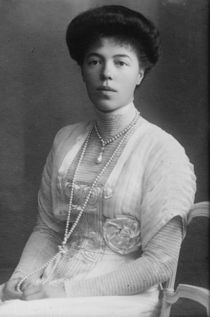 |
|
| Spouse | (1) Duke Peter Alexandrovich of Oldenburg (2) Nikolai Kulikovsky |
| Issue | |
| Tikhon Nikolaevich Kulikovsky (1917–1993) Guri Nikolaevich Kulikovsky (1919–1984) |
|
| House | House of Holstein-Gottorp-Romanov |
| Father | Alexander III of Russia |
| Mother | Empress Marie Feodorovna |
| Born | 13 June 1882 Peterhof Palace, Saint Petersburg, Russian Empire |
| Died | 24 November 1960 (aged 78) Toronto, Ontario, Canada |
Grand Duchess Olga Alexandrovna of Russia (Russian: О́льга Алекса́ндровна Рома́нова; Olga Alexandrovna Romanova) (13 June [O.S. 1 June] 1882 – 24 November 1960) was the youngest child of Emperor Alexander III of Russia. Her older brother was Tsar Nicholas II.
Olga's relationship with her mother, Empress Marie, the daughter of King Christian IX of Denmark, was strained and distant from childhood.[1] In contrast, she and her father enjoyed their time together and shared intimate secrets. She was raised at the Gatchina Palace outside of Saint Petersburg, and was close to her brother, Michael, although their relationship later deteriorated.
In 1901, she married Duke Peter Alexandrovich of Oldenburg, who was privately considered by family and friends to be homosexual.[2] The marriage did not last and was annulled in 1916, allowing Olga to marry commoner Nikolai Kulikovsky, whom she had fallen in love with during her first marriage. After the downfall of the Romanovs in the Russian Revolution of 1917, she fled to the Crimea with her mother, husband, and children, where they were placed under house arrest and lived under the threat of assassination. Her brother and his family, including Olga's niece Grand Duchess Anastasia, were murdered by communists. After her escape from revolutionary Russia in 1919, Olga was often sought out by Romanov impostors who claimed to be her dead relatives. She met Anna Anderson, the best-known Anastasia impostor, in a highly publicized visit to Berlin in 1925.
Olga lived in Denmark until 1948 when, feeling threatened by Stalin's regime, she moved her direct family to a farm in Campbellville, Ontario, Canada. Like her father, Olga preferred to avoid extravagance and sought simplicity. During her lifetime, she painted over 2,000 works of art, which provided income for both her family and the charitable causes she supported. She lived in Canada until her death in a flat in East Toronto at the age of 78. She was the last surviving grandchild of Alexander II of Russia, and died seven months after her older sister, Xenia. At the end of her life and afterwards, Olga was widely labelled the last Grand Duchess of Imperial Russia.
Contents |
Early life

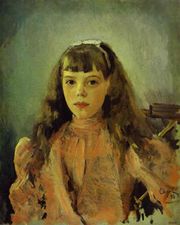
Olga was the youngest daughter of Tsar Alexander III and his consort, Marie Feodorovna, formerly Princess Dagmar of Denmark. She was born in the purple, i.e. during her father's reign, on 13 June 1882 in the Peterhof Palace, west of Saint Petersburg. The traditional 101-gun salute from the ramparts of the Peter and Paul Fortress announced the news to the Russian Empire, and was followed by similar salutes throughout Russia.[3] Her mother, advized by her sister, Alexandra, Princess of Wales, placed Olga in the care of an English nanny, Elizabeth Franklin.[3]
The Russian imperial family was a frequent target for assassins, so for safety reasons the Grand Duchess was raised at the country palace of Gatchina, about 50 miles (80 km) west of Saint Petersburg. However, Olga and her siblings were not accustomed to a lavish early lifestyle. Conditions in the nursery were modest, even Spartan.[4] They slept on hard camp beds, rose at dawn, washed in cold water, and ate a simple porridge for breakfast.[4]
Olga, her father, and her brother Michael had a close relationship. Together, the three frequently went on hikes within the Gatchina forests, where the Tsar taught Olga and Michael woodsmanship.[5] Olga said of her father:
My father was everything to me. Immersed in work as he was, he always spared that daily half-hour. … once my father showed me a very old album full of most exciting pen and ink sketches of an imaginary city called Mopsopolis, inhabited by Mopses. He showed it to me in secret, and I was thrilled to have him share his own childhood secrets with me.[6]
Olga left Gatchina for the first time in the early fall of 1888 when the imperial family visited the Caucasus. On 29 October, they were returning by train, travelling towards Kharkov at speed. At about 1 p.m., the train approached the small town of Borki. The Tsar, Tsarina and their four older children were in the dining-car for lunch. As the pudding was brought in, the train lurched violently throwing everyone to the floor. The carriage was torn open; the heavy iron roof caved in, and the wheels and floor of the car were sliced off. The Tsar crawled out from beneath the crushed roof, and held it up with "a Herculean effort" so that the others could escape.[7] There were 21 fatalities among the casualties. The Tsarina helped tend the wounded, and made makeshift bandages from her own clothes.[8] The crash was officially blamed on rotten railway lines,[9] but it was widely assumed that two bombs had been planted on the line.[8]
The Grand Duchess and her siblings were taught at home by private tutors. Subjects included history, geography, Russian, English and French, as well as drawing and dancing.[10] Physical activities such as equestrianism were also taught at an early age, eventually making the young Romanovs expert riders.[11] Although Christmas and Easter were times of celebration and extravagance, the family was deeply religious. Lent was strictly observed—meat, dairy products and any form of entertainment were avoided.[12] Family holidays were taken in the summer at Peterhof and with Olga's grandparents in Denmark.[13]
During 1894 Olga's father the Tsar became increasingly ill, and the annual trip to Denmark was cancelled.[14] On 13 November 1894, he died at the age of 49. The emotional impact on Olga, aged only 12, was traumatic,[15] and her brother, the new Tsar Nicholas II, was propelled into a role for which in Olga's later opinion he was ill-prepared.[16]
Tsarskoye Selo
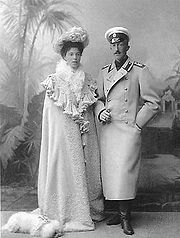
Olga was due to enter society in the summer of 1899, but after the death of her brother George at the age of 27, her first official public appearance was delayed by a year until 1900.[17] She hated the experience, and later told her official biographer, "I felt as though I were an animal in a cage—exhibited to the public for the first time."[18]
At the age of 19, on 9 August 1901, the Grand Duchess married 33-year-old Duke Peter Alexandrovich of Oldenburg, a member of the Russian branch of the House of Oldenburg. The marriage, announced in May, was unexpected by many, as Peter had shown no prior interest in women.[18] His proposal even came as a surprise to Olga, who later explained, "I was so taken aback that all I could say was 'thank you'".[19] She assumed that Peter was pushed into proposing by his ambitious mother.[20] Perhaps Olga accepted his proposal to gain independence from her own mother, the Dowager Empress Marie, or avoid marriage into a foreign court.[21] Their marriage remained unconsummated,[22] and the couple moved into a 200-room house on Sergievskaya street in Saint Petersburg.[23] From 1901, Olga was appointed honorary Commander-in-Chief of the 12th Akhtyrsky Hussar Regiment of the Imperial Russian Forces. The Akhtyrsky Hussars were famous for their victory over Napoleon Bonaparte at the Battle of Kulm in 1813, and wore a distinctive brown dolman.[24]
Olga had her own villa, called "Olgino" after the local town, near to the Oldenburg's estate, Ramon near Voronezh.[25] In the adjacent villages, she helped improve the basic medical and educational provision by subsidizing the village school out of her own pocket, and establishing a hospital.[26] Her daughter-in-law later wrote, "She tried to help every needy person as far as her strengths and means would permit."[26] At the hospital, she learned how to administer medical treatment and proper care of the ill from the local doctor.[27] She practiced and exemplified her Orthodox faith by creating religious icons, which she distributed to the charitable endeavours she supported.[26]
In the year 1903, she was introduced to a Blue Cuirassier Guards officer Nikolai Kulikovsky by her brother Michael during a royal military review at Pavlovsk.[28] Olga and Kulikovsky began to see each other more often, and exchanged letters regularly. The same year, at the age of 22, she confronted her husband and asked for a divorce, which he refused with the qualification that he might reconsider after seven years.[29] Oldenburg appointed Kulikovsky as an aide-de-camp, however, and allowed him to live in the same residence as Oldenburg and the Grand Duchess on Sergievskaya street.[30] For the few who knew, the relationship between Kulikovsky and the Grand Duchess was a guarded secret,[31] but gossip about their romance still spread through society.[32]
From 1904 to 1906, Duke Peter was appointed to a military post in Tsarskoye Selo, a complex of palaces just south of Saint Petersburg. In Tsarskoye Selo, the Grand Duchess grew close to her brother Nicholas, and his family, who lived at the Alexander Palace near her own residence.[33] Olga prized her connection to the Tsar's four daughters, and was deeply trusted by both the Tsar and Tsarina.[34] From 1906 to 1914, the Grand Duchess took her nieces to parties and engagements in Saint Petersburg every weekend throughout the winter.[34] She especially took a liking to the youngest of Nicholas's daughters, her god-daughter Anastasia, whom she called Shvipsik ("little one").[35] The Tsar and Tsarina were very protective parents and trusted few with the care of their children. Through her brother and sister-in-law, Olga met Rasputin, a self-styled holy man who purported to have healing powers. Although she made no public criticisms of Rasputin's association with the imperial family, she was unconvinced of his supposed powers and privately disliked him.[36] As Olga grew close to her brother's family, her relationship with her other surviving brother, Michael, deteriorated. To her and Nicholas's horror, Michael eloped with his mistress, a twice-divorced commoner, and communication between Michael and the rest of the family was essentially cut off.[37]
Public unrest over the Russo-Japanese War and demands for political reform increased in the early years of the twentieth century. At Epiphany 1905, a band of revolutionaries fired live rounds at the Winter Palace from the Peter and Paul Fortress. Olga and the Dowager Empress were showered with glass splinters from a smashed window, but were unharmed.[38] Three weeks later, on "Bloody Sunday", at least 92 people were killed by Cossack troops during a demonstration,[39] and a month later Olga's uncle, Grand Duke Sergei Alexandrovich of Russia, was assassinated.[40] Uprisings occurred throughout the country, and parts of the navy mutinied.[41] Olga supported the appointment of the liberal Pyotr Stolypin as prime minister, and he embarked on a program of gradual reform, but in 1911 he was assassinated.[42] The public unrest, Michael's elopement, and Olga's sham marriage placed her under strain, and in 1913, while visiting England, she suffered a nervous breakdown.[43] On the way back to Russia, through Denmark, she recuperated.[44]
On 1 August 1914, Olga's regiment, the Akhtyrsky Hussars, appeared at an Imperial Review before the Grand Duchess and the Tsar at Krasnoe Selo. Just a few days later, World War I erupted.[45] Kulikovsky volunteered for service with the Hussars, who were stationed on the frontlines in Southwestern Russia.[24] With the Grand Duchess's prior medical knowledge from the village of Olgino, she started work as a nurse at an under-staffed Red Cross hospital in Rovno, near to where her own regiment was stationed.[46] During the war, she came under heavy Austrian fire while attending the regiment at the front. Nurses rarely worked so close to the frontlines and consequently the Grand Duchess was awarded the Order of St. George for her actions by General Mannerheim, who later became President of Finland.[24] As the Russians lost ground to the Central Powers, Olga's hospital was moved eastwards to Kiev,[47] and Michael returned to Russia from exile abroad.[48]
Fall of the House of Romanov

In 1916, Tsar Nicholas II officially annulled the marriage between Duke Peter Alexandrovich and the Grand Duchess, allowing her to marry Colonel Kulikovsky on 16 November 1916 in the Kievo-Vasilievskaya Church on Triokhsviatitelskaya (Three Saints Street) in Kiev.[49] Only the Dowager Empress Marie, Olga's brother-in-law Grand Duke Alexander, four officers of the Akhtyrsky Regiment, two fellow nurses from the hospital in Kiev and the officiating priest attended.[50]
During the war, internal tensions and economic deprivation in Russia continued to mount and revolutionary sympathies grew. After her brother Tsar Nicholas II was deposed in early 1917, many members of the Romanov dynasty, including Nicholas and his immediate family, were detained under house arrest. The Dowager Empress, Grand Duke Alexander, and Grand Duchess Olga managed to escape to the Crimea by special train, where they were joined by Grand Duchess Xenia.[51] They lived at Alexander's estate, Ay-Todor , about 12 miles (19 km) from Yalta, where they were placed under house arrest by the local forces.[52] On 12 August 1917, her first child and son, Tikhon Nikolaevich Kulikovsky was born during their virtual imprisonment. He was named after the local Saint venerated near the Grand Duchess's estate at Olgino, Tikhon of Zadonsk.[24] Although Tikhon was the grandson of an emperor and the nephew of another, neither he nor his younger brother Guri received any title as his father was a commoner.
The Romanovs isolated in the Crimea knew little of the fate of the Tsar and his family. Nicholas, Alexandra, and their children, were originally held at their official residence, the Alexander Palace, but the Provisional government under Alexander Kerensky relocated them to Tobolsk, Siberia. In February 1918, most of the imperial family at Ay-Todor was moved to Djulber, where Grand Dukes Nicholas and Peter were already under house arrest. Olga and her husband were left at Ay-Todor. The entire Romanov family in the Crimea was condemned to death by the Yalta revolutionary council, but the executions were delayed by political rivalry between the Yalta and Sevastopol Soviets.[53] By March 1918, the Central Power of Germany had advanced on the Crimea, and the revolutionary guards were replaced by German ones.[54] In November 1918, the German forces were informed that their nation had lost the war, and they evacuated homewards. Allied forces took over the Crimean ports, in support of the loyalist White Army, which temporarily allowed the surviving members of the Romanov family time to escape abroad. The Dowager Empress Marie and, at her insistence, most of her family and friends were evacuated by the British warship HMS Marlborough. Nicholas II, however, had already been assassinated and the family assumed, correctly, that his wife and children had also been killed. The fate of Olga's childhood confidant and brother Michael, the emperor's supposed successor, was uncertain. It was unknown to the Grand Duchess at the time, but he had been assassinated near Perm on 12 June 1918.
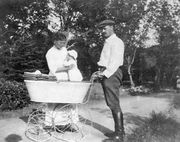
Olga and her husband refused to leave Russia, and decided to make for the Caucasus, which the White Army had cleared of revolutionary Bolsheviks.[55] An imperial bodyguard, Timofei Yatchik, guided them to his hometown, the large Cossack village of Novominskaya. In a rented five-roomed farmhouse there, their second son, Guri Nikolaevich Kulikovsky, was born on 23 April 1919.[56] He was named after a friend of the Grand Duchess, Guri Panayev, who was killed while serving in the Akhtyrsky Regiment during World War I. In November 1919, the family set out on what would be their last journey through Russia. Just ahead of revolutionary troops, they escaped to Novorossiysk, and took refuge in the residence of the Danish consul, Thomas Schytte, who informed them of the Dowager Empress's safe arrival in Denmark.[57] After a brief stay with the Danish consul, the family were shipped to a refugee camp on the island of Büyükada in the Dardanelles Strait near Istanbul, Turkey, where Olga, her husband and children shared three rooms with eleven other adults.[58] After two weeks, they were evacuated to Belgrade in the Kingdom of Serbs, Croats and Slovenes where she was visited by Regent Alexander Karageorgevich, later King Alexander I of Yugoslavia. Alexander offered the Grand Duchess and her family a permanent home, but the Dowager Empress summoned her daughter to Denmark.[57] On Good Friday 1920, the Grand Duchess arrived in Copenhagen. Olga lived with her mother, the Dowager Empress Marie, at first at the Amalienborg Palace and then at the royal estate of Hvidøre, acting as her secretary and companion.[59]
Anna Anderson
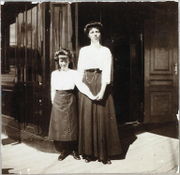
In 1925, Olga and Colonel Kulikovsky travelled to Berlin to meet Anna Anderson, who claimed to be Olga's niece, Grand Duchess Anastasia Nikolaevna of Russia. Anderson had attempted suicide in Berlin in 1920, which Olga later called "probably the only indisputable fact in the whole story".[60] Anderson claimed that with the help of a man named Tchaikovsky she had escaped from revolutionary Russia via Bucharest, where she had given birth to his child. Olga thought the story "palpably false",[61] since Anderson made no attempt to approach Queen Marie of Romania, during her entire alleged time in Bucharest. Olga said:
...in 1918 or 1919. If Mrs. Anderson had indeed been Anastasia, Queen Marie would have recognised her on the spot. ... Marie would never have been shocked at anything, and a niece of mine would have known it. ... There is not one tittle of genuine evidence in the story. The woman keeps away from the one relative who would have been the first to recognize her, understand her desperate plight, and symphathize with her.[61]
Anderson stated she was in Berlin to inform Princess Irene of Prussia (sister of Empress Alexandra and cousin of Tsar Nicholas II) of her survival. Olga commented, "[Princess Irene] was one of the most straightlaced women in her generation. My niece would have known that her condition would have indeed have shocked [her]."[62]
Olga met Anderson, who was being treated for tuberculosis, at a nursing home. Of the visit Olga later said:
My beloved Anastasia was fifteen when I saw her for the last time in the summer of 1916. She would have been twenty-four in 1925. I thought Mrs. Anderson looked much older than that. Of course, one had to make allowances for a very long illness ... All the same, my niece's features could not possibly have altered out of all recognition. The nose, the mouth, the eyes were all different.[63] ... As soon as I sat down by that bed in the Mommsen Nursing Home, I knew I was looking at a stranger. … I had left Denmark with something of a hope in my heart. I left Berlin with all hope extinguished.[64]
In addition, Olga said she was dismayed that Anderson spoke only German and showed no sign of knowing either English or Russian, while Anastasia spoke both those languages fluently and was ignorant of German.[65] Nevertheless, Olga remained sympathetic towards Anderson, perhaps because she thought that she was ill rather than deliberately deceitful.[66] Olga later explained:
...she did not strike me as an out-and-out impostor. Her brusqueness warred against it. A cunning impostor would have done all she could to ingratiate herself ... But Mrs. Anderson's manner would have put anyone off. My own conviction is that it all started with some unscrupulous people who hoped they might lay their hands on at least a share of the fabulous and utterly non-existent Romanov fortune ... I had a feeling she was 'briefed,' as it were, but far from perfectly. The mistakes she made could not all be attributed to lapses of memory. For instance, she had a scar on one of her fingers and she kept telling everybody that it had been crushed because of a footman shutting the door of a landau too quickly. And at once I remembered the real incident. It was Marie, her elder sister, who got her hand hurt rather badly, and it did not happen in a carriage but on board the imperial train. Obviously someone, having heard something of the incident, had passed a garbled version of it to Mrs. Anderson."[64]
Conceivably, Olga was initially either open to the possibility that Anderson was Anastasia or unable to make up her mind.[67] Anderson's biographer and supporter Peter Kurth claimed that Olga wrote to the Danish ambassador, Herluf Zahle, at the end of October 1925: "My feeling is that she is not the one she believes—but one can't say she is not as a fact".[68] However, within a month she had made up her mind. She wrote to a friend, "There is no resemblance, and she is undoubtedly not A."[69][70] Olga sent Anderson a scarf and five letters , which were used by Anderson's supporters to claim that Olga recognized Anderson as Anastasia.[71] Olga later said she sent the gift and letters "out of pity",[72] and called the claims "a complete fabrication".[72] When Olga refused to recognize Anderson as Anastasia publicly and published a statement denying any resemblance in a Danish newspaper,[73] Anderson's supporters, Harriet von Rathlef and Gleb Botkin, claimed that Olga was acting on instructions received from her sister Grand Duchess Xenia by telegram, which Olga denied in private letters and sworn testimony.[74][75] She told her biographer, "I never received any such telegram."[72] The supposed telegram was never produced by Anderson's supporters, and it has never been found among any of the papers relating to the case.[76] Xenia said,
[Anderson's supporters] told the most terrible lies about my sister and me ... I was supposed to have sent Olga a telegram saying, 'On no account recognize Anastasia.' That was a fantasy. I never sent any telegrams, or gave my sister any advice about her visit to Berlin. We were all apprehensive about the wisdom of her going, but only because we feared it would be used for propaganda purposes by the claimant's supporters. ... My sister Olga felt sorry for that poor woman. She was kind to her, and because of her kindness of heart, her opinions and motives have been misrepresented.[77]
Danish residency and exodus
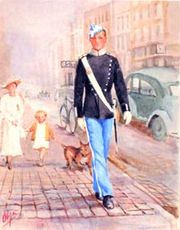
The Dowager Empress died on 13 October 1928 at Hvidøre. Her estate was sold and Olga purchased Knudsminde, a farm in Ballerup about 15 miles (24 km) from Copenhagen, with her portion of the proceeds.[78] Her farm-estate became a centre for the Russian monarchist community in Denmark and many Russian emigrants visited.[79] She maintained a high level of correspondence with the Russian émigré community and former members of the Russian Imperial army.[57] In the 1930s, the family took annual holidays in Sophiro, Sweden, with Crown Prince Gustaf of Sweden and his wife, Louise.[80] Olga began to sell her own paintings of Russian and Danish scenes, with exhibition auctions in Copenhagen, London, Paris, and Berlin. Some of the proceeds were donated to the charities she supported.[57]
Neutral Denmark was invaded by Nazi Germany on 9 April 1940, and was occupied for the remainder of World War II. Food shortages, communication restrictions, and transportation closures followed. As Olga's sons, Tikhon and Guri, served as officers in the Danish Army, they were interned as prisoners of war, but their imprisonment in a Copenhagen hotel lasted less than two months.[81] Tikhon was imprisoned for a further month in 1943 after being arrested on charges of espionage.[82] Other Russian émigrés, keen to fight against the Soviets, enlisted in the German forces. Despite her sons' internment and her mother's Danish origins, Olga was implicated in her compatriots' collusion with German forces, as she continued to meet and extend help to Russian émigrés fighting against communism.[83] On 4 May 1945, German forces in Denmark surrendered to the British. When economic and social conditions for Russian exiles failed to improve, General Pyotr Krasnov wrote to the Grand Duchess, detailing the wretched conditions affecting Russian immigrants in Denmark.[84] She in turn asked Prince Axel of Denmark to help them, but her request was refused.[85]
The Soviet Union wrote to the Danish government accusing the Grand Duchess and a Danish Catholic bishop of conspiracy against the Soviet government.[86] With the end of World War II, Soviet troops came close to the Danish border, and the surviving Romanovs in Denmark grew fearful of an assassination or kidnap attempt.[87] Olga decided to move her family across the Atlantic to the relative safety of rural Canada.[88]
Emigration to Canada
In May 1948, the Kulikovskys travelled to London by Danish troopship. They were housed in a grace and favour apartment at Hampton Court Palace while arrangements were made for their journey to Canada as agricultural immigrants.[89] On 2 June 1948, Olga, Kulikovsky, Tikhon and his Danish-born wife Agnete, Guli and his Danish-born wife Ruth, Guli and Ruth's two children, Xenia and Leonid, and Olga's devoted companion and former maid Emilia Tenso ("Mimka") departed Liverpool for Canada on board the Empress of Canada.[90]
After a rough crossing, the ship docked at Halifax, Nova Scotia.[91] The family proceeded to Toronto, where they lived until they purchased a 200 -acre farm in Halton County, Ontario, near Campbellville.[92] In 1951, former officers and members of the Akhtyrsky Regiment gathered at Olga's home to celebrate the 300th anniversary of its foundation, and she became the patroness of the Association of Russian Cadets of Toronto.[93]
By 1952, the farm had become a burden to Olga and her husband. They were both elderly; their sons had moved away; labour was hard to come by; the Colonel suffered increasing ill-health, and some of Olga's remaining jewellery was stolen.[94] The farm was sold, and Olga, her husband and her former maid, Mimka, moved to a smaller 5-room house at 2130 Camilla Road, Cooksville, Ontario, a suburb of Toronto (now amalgamated into the city of Mississauga) .[95] Mimka suffered a stroke that left her an invalid, and Olga nursed her until Mimka's death on 24 January 1954.[96] Neighbours and visitors to the region, including foreign and royal dignitaries, took interest in her, and visited her small home, which was also a magnet for Romanov impostors whom Olga and her family considered a menace.[97] Welcome visitors included Princess Marina, Duchess of Kent, in 1954,[98] and Louis Mountbatten and his wife Edwina, in August 1959.[99] In June 1959, Queen Elizabeth II and Prince Philip visited Toronto and invited the Grand Duchess for lunch onboard the Royal Yacht, Britannia.[100]
By 1958, Olga's husband was virtually paralyzed, and Olga sold some of her remaining jewellery in an attempt to raise funds.[101] Following her husband's death in 1958, the Grand Duchess became increasingly infirm until hospitalized in April 1960 at Toronto General Hospital.[102] Unable to care for herself, she went to stay with Russian émigré friends, Konstantin and Sinaida Martemianoff, in an apartment above a beauty salon in Gerrard Street East, Toronto.[103] On 21 November 1960, she slipped into a coma, and she died on 24 November, at the age of 78.[104]
The Grand Duchess was interred next to her husband in York Cemetery, Toronto, on 30 November 1960. The funeral service at Christ the Saviour Cathedral, Toronto, was attended by numerous immigrants as well as many of the friends she had made in her new homeland.[105] Officers of the Akhtyrsky Hussars and the Blue Cuirassiers stood guard in the small Russian church, which overflowed with mourners.[106] Although she lived simply, bought cheap clothes, and did her own shopping and gardening, her estate was valued at more than 200,000 Canadian dollars, and was probably worth more.[107]
Legacy
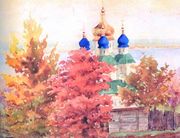
The Grand Duchess began drawing and painting at a young age. She told her biographer:
Even during my geography and arithmetic lessons, I was allowed to sit with a pencil in my hand. I could listen much better when I was drawing corn or wild flowers.[108]
She painted throughout her life, on paper, canvas and ceramic, and her output is estimated at over 2,000 pieces.[109] Her usual medium was scenery and landscape, but she also painted portraits and still lifes. Her daughter-in-law wrote,
Being a deeply religious person, the Grand Duchess perceived the beauty of nature as being divinely inspired creation. Prayer and attending church provided her with the strength not only to overcome the new difficulties befallen her, but also to continue with her drawing. These feelings of gratefulness to God pervaded not only the icons created by the Grand Duchess, but also her portraits and still life paintings.[84]
Her official biographer Ian Vorres wrote,
Her paintings, vivid and sensitive, are immersed in the subdued light of her beloved Russia. Besides her numerous landscapes and flower pictures that reveal her inherent love for nature, she often also dwells on scenes from simple daily life ... executed with a sensitive eye for composition, expression and detail. Her work exudes peace, serenity and a spirit of love that mirror her own character, in total contrast to the suffering she experienced through most of her life.[109]
Her paintings were a profitable source of income.[110] According to her daughter-in-law, Olga preferred to exhibit in Denmark to avoid the commercialism of the North American market.[93] The Russian Relief Programme, which was founded by Tikhon and his third wife Olga in honour of the Grand Duchess,[111] exhibited a selection of her work at the residence of the Russian ambassador in Washington in 2001, in Moscow in 2002, in Ekaterinburg in 2004, in Saint Petersburg and Moscow in 2005, in Tyumen and Surgut in 2006, and at the Tretyakov Gallery in Moscow and Saint Michael's Castle in Saint Petersburg in 2007.[112] Pieces by Olga are included in the collections of Queen Elizabeth II, Prince Philip, Duke of Edinburgh, King Harald of Norway, and private collections in North America and Europe.[109] Ballerup Museum in Pederstrup, Denmark, has around 100 of her works.[113]
Ancestry
| Ancestors of Grand Duchess Olga Alexandrovna of Russia | ||||||||||||||||||||||||||||||||||||||||||||||||||||||||||||||||||||||||||||||||||||||||||||||||||||||||||||||||||||||||||||||||||||||||||||||||||||||||||||||||||||||||||||||||||||||||||||||||||||||||||||||||||||||||||||||||||||||||||||||||||||||||||||||||||||||||||||||||||||||||||||||||||||||||||||||||||||||||||||||||||||||||||||||||||||||||||||||||||||||||||||||||||||||||||||||||||||||||||||||||||||||||||||||||||||||||||||||||||||||||||||||||||||||||||||||||||||||||||||||||||||||||||||||||||||||||||||||||||||||||||||||||||||||||||||||||||
|---|---|---|---|---|---|---|---|---|---|---|---|---|---|---|---|---|---|---|---|---|---|---|---|---|---|---|---|---|---|---|---|---|---|---|---|---|---|---|---|---|---|---|---|---|---|---|---|---|---|---|---|---|---|---|---|---|---|---|---|---|---|---|---|---|---|---|---|---|---|---|---|---|---|---|---|---|---|---|---|---|---|---|---|---|---|---|---|---|---|---|---|---|---|---|---|---|---|---|---|---|---|---|---|---|---|---|---|---|---|---|---|---|---|---|---|---|---|---|---|---|---|---|---|---|---|---|---|---|---|---|---|---|---|---|---|---|---|---|---|---|---|---|---|---|---|---|---|---|---|---|---|---|---|---|---|---|---|---|---|---|---|---|---|---|---|---|---|---|---|---|---|---|---|---|---|---|---|---|---|---|---|---|---|---|---|---|---|---|---|---|---|---|---|---|---|---|---|---|---|---|---|---|---|---|---|---|---|---|---|---|---|---|---|---|---|---|---|---|---|---|---|---|---|---|---|---|---|---|---|---|---|---|---|---|---|---|---|---|---|---|---|---|---|---|---|---|---|---|---|---|---|---|---|---|---|---|---|---|---|---|---|---|---|---|---|---|---|---|---|---|---|---|---|---|---|---|---|---|---|---|---|---|---|---|---|---|---|---|---|---|---|---|---|---|---|---|---|---|---|---|---|---|---|---|---|---|---|---|---|---|---|---|---|---|---|---|---|---|---|---|---|---|---|---|---|---|---|---|---|---|---|---|---|---|---|---|---|---|---|---|---|---|---|---|---|---|---|---|---|---|---|---|---|---|---|---|---|---|---|---|---|---|---|---|---|---|---|---|---|---|---|---|---|---|---|---|---|---|---|---|---|---|---|---|---|---|---|---|---|---|---|---|---|---|---|---|---|---|---|---|---|---|---|---|---|---|---|---|---|---|---|---|---|---|---|---|---|---|---|---|---|---|---|---|---|---|---|---|---|---|---|---|---|---|---|---|---|---|---|---|---|---|---|---|---|---|---|---|---|---|---|---|---|---|---|---|---|---|---|---|---|---|---|---|---|---|---|---|---|---|---|---|---|---|---|---|---|---|---|---|---|---|---|---|---|---|---|---|---|---|---|---|---|---|---|---|---|---|---|---|---|---|---|---|---|---|---|---|---|---|---|---|---|---|---|---|---|---|---|---|---|---|---|---|---|---|---|---|---|---|---|---|---|---|---|---|---|---|---|---|---|---|---|---|---|---|
|
||||||||||||||||||||||||||||||||||||||||||||||||||||||||||||||||||||||||||||||||||||||||||||||||||||||||||||||||||||||||||||||||||||||||||||||||||||||||||||||||||||||||||||||||||||||||||||||||||||||||||||||||||||||||||||||||||||||||||||||||||||||||||||||||||||||||||||||||||||||||||||||||||||||||||||||||||||||||||||||||||||||||||||||||||||||||||||||||||||||||||||||||||||||||||||||||||||||||||||||||||||||||||||||||||||||||||||||||||||||||||||||||||||||||||||||||||||||||||||||||||||||||||||||||||||||||||||||||||||||||||||||||||||||||||||||||||
Notes and sources
- ↑ Phenix, p. 8; Vorres (2001), p. 25
- ↑ Phenix, p. 52
- ↑ 3.0 3.1 Vorres (2001), p. 3
- ↑ 4.0 4.1 Phenix, pp. 8–10; Vorres (2001), p. 4
- ↑ Vorres (2001), p. 24
- ↑ Vorres (2001), pp. 9–11
- ↑ Vorres (2001), p. 11
- ↑ 8.0 8.1 Vorres (2001), p. 12
- ↑ Phenix, p. 20
- ↑ Vorres (2001), pp. 18–20
- ↑ Phenix, pp. 12–13; Vorres (2001), pp. 26–27
- ↑ Vorres (2001), p. 30
- ↑ Phenix, pp. 11, 24; Vorres (2001), pp. 33–41
- ↑ Vorres (2001), pp. 48–52
- ↑ Phenix, pp. 30–31; Vorres (2001), pp. 54, 57
- ↑ Vorres (2001), p. 55
- ↑ Phenix, p. 45; Vorres (2001), pp. 72–74
- ↑ 18.0 18.1 Vorres (2001), p. 74
- ↑ Vorres (2001), p. 75
- ↑ Vorres (2001), pp. 75, 78
- ↑ Phenix, p. 46
- ↑ Olga said: "I shared his roof for nearly fifteen years, and never once we were husband and wife" (Vorres (2001), p. 76). See also, Massie, p. 171.
- ↑ Vorres (2001), p. 81
- ↑ 24.0 24.1 24.2 24.3 Kulikovsky-Romanoff, p. 4
- ↑ Vorres (2001), pp. 78–79
- ↑ 26.0 26.1 26.2 Kulikovsky-Romanoff, p. 3
- ↑ Vorres (2001), p. 79
- ↑ Crawford and Crawford, p. 51; Phenix, p. 62; Vorres (2001), pp. 94–95
- ↑ Phenix, p. 63; Vorres (2001), p. 95
- ↑ Crawford and Crawford, p. 52; Phenix, p. 73; Vorres (2001), pp. 94–95
- ↑ Vorres (2001), pp. 95–96
- ↑ A Cuirassier's Memoirs by Vladimir Trubetskoy, quoted in Phenix, p. 73
- ↑ Vorres (2001), pp. 97–99, 101
- ↑ 34.0 34.1 Massie, p. 171; Vorres (2001), pp. 102–103
- ↑ Phenix, p. 144; Vorres (2001), pp. 98–99
- ↑ Phenix, pp. 73–83; Vorres (2001), pp. 127–139
- ↑ Phenix, pp. 85–88; Vorres (2001), pp. 108–109
- ↑ Phenix, p. 68; Vorres (2001), p. 111
- ↑ Phenix, p. 69; Vorres (2001), p. 111
- ↑ Phenix, p. 69; Vorres (2001), p. 112
- ↑ Vorres (2001), p. 113
- ↑ Vorres (2001), pp. 117–119
- ↑ Phenix, p. 89; Vorres (2001), pp. 121–122
- ↑ Vorres (2001), p. 122
- ↑ Vorres (2001), p. 125
- ↑ Phenix, pp. 91–92; Vorres (2001), p. 141
- ↑ Phenix, p. 93; Vorres (2001), p. 143
- ↑ Phenix, p. 101
- ↑ Phenix, p. 103
- ↑ Grand Duke Alexander's Memoirs, Once A Grand Duke, p. 273, quoted in Phenix, p. 104
- ↑ Phenix, pp. 115–117; Vorres (2001), pp. 149–150
- ↑ Phenix, p. 118
- ↑ Phenix, pp. 122–123; Vorres (2001), pp. 155–156
- ↑ Phenix, pp. 123–125; Vorres (2001), pp. 156–157
- ↑ Phenix, p. 128; Vorres (2001), p. 159
- ↑ Phenix, p. 129
- ↑ 57.0 57.1 57.2 57.3 Kulikovsky-Romanoff, p. 5
- ↑ Phenix, p. 132
- ↑ Vorres (2001), pp. 167–171
- ↑ Olga quoted in Vorres (2001), p. 173
- ↑ 61.0 61.1 Olga quoted in Vorres (2001), p. 175
- ↑ Olga quoted in Vorres (2001), p. 175
- ↑ Olga quoted in Massie, p. 174 and Vorres (2001), p. 174
- ↑ 64.0 64.1 Olga quoted in Vorres (2001), p. 176
- ↑ "My nieces knew no German at all. Mrs. Anderson did not seem to understand a word of Russian or English, the two languages all the four sisters had spoken since babyhood.": Olga quoted in Vorres (2001), p. 174
- ↑ Klier and Mingay, p. 156; Vorres (2001), p. 176
- ↑ Klier and Mingay, p. 102; Massie, p. 174; Phenix, p. 155
- ↑ Letter from Olga to Herluf Zahle, 31 October 1925, quoted in Kurth, p. 119, but with a proviso that the original letter has never been seen
- ↑ Letter from Olga to Colonel Anatoly Mordvinov, 4 December 1925, Oberlandesgericht Archive, Hamburg, quoted in Kurth, p. 120
- ↑ Olga wrote in a letter to Tatiana Melnik, 30 October 1926, Botkin Archive, quoted in Kurth, p. 144; and a letter dated 13 September 1926 quoted in von Nidda, pp. 197–198: "However hard we tried to recognize this patient as my niece Tatiana or Anastasia, we all came away quite convinced of the reverse." In a letter from Olga to Princess Irene, 22 December 1926, quoted in von Nidda, p.168, she wrote, "I had to go to Berlin last autumn to see the poor girl said to be our dear little niece. Well, there is no resemblance at all, and it is obviously not Anastasia ... It was pitiful to watch this poor creature trying to prove she was Anastasia. She showed her feet, a finger with a scar and other marks which she said were bound to be recognised at once. But it was Maria who had a crushed finger, and someone must have told her this. For four years this poor creature's head was stuffed with all these stories ... It has been claimed, however, that we all recognised her and were then given instructions by Mama to deny that she was Anastasia. That is a complete lie. I believe this whole story is an attempt at blackmail."
- ↑ Klier and Mingay, p. 102; Vorres (2001), p. 177
- ↑ 72.0 72.1 72.2 Olga quoted in Vorres (2001), p. 177
- ↑ National Tidende, 16 January 1926, quoted in Klier and Mingay, p. 102 and Phenix, p. 155
- ↑ "I can swear to God that I did not receive before or during my visit to Berlin, either a telegram or a letter from my sister Xenia advising that I should not acknowledge the stranger.": Sworn testimony of Grand Duchess Olga, Staatsarchiv Hamburg, File 1991 74 0 297/57 Volume 7, pp. 1297–1315, quoted in Phenix, p. 238
- ↑ "They state that we all recognized her and that we then received an order from Mama to say that she is not Anastasia. This is a great lie!": Letter from Olga to Princess Irene, quoted in Klier and Mingay, p. 149
- ↑ Phenix, p. 238
- ↑ Xenia to Michael Thornton, quoted in a letter from Thornton to Patricia Phenix, January 10, 1998, quoted in Phenix, p. 237–238
- ↑ Phenix, p. 168; Vorres (2001), p. 185
- ↑ Phenix, p. 170
- ↑ Vorres (2001), p. 186
- ↑ Phenix, p. 174
- ↑ Phenix, p. 176
- ↑ Phenix, p. 176; Vorres (2001), p. 187
- ↑ 84.0 84.1 Kulikovsky-Romanoff, p. 6
- ↑ Phenix, p. 178
- ↑ Phenix, p. 179
- ↑ Phenix, pp. 179–180; Vorres (2001), pp. 187–188
- ↑ Mr. J. S. P. Armstrong, Agent General for Ontario, quoted in Vorres (2001), p. 191
- ↑ Vorres (2001), pp. 188, 190
- ↑ Vorres (2001), p. 193
- ↑ Vorres (2001), p. 196
- ↑ Vorres (2001), pp. 196–198
- ↑ 93.0 93.1 Kulikovsky-Romanoff, p. 8
- ↑ Vorres (2001), pp. 207–208
- ↑ Phenix, pp. 205–206; Vorres (2001), p. 209
- ↑ Phenix, p. 207; Vorres (2001), p. 210
- ↑ Vorres (2001), pp. 200–205
- ↑ Phenix, p. 214; Vorres (2001), p. 211
- ↑ Vorres (2001), p. 221
- ↑ Phenix, pp. 238–239; Vorres (2001), p. 207
- ↑ Vorres (2001), p. 219
- ↑ Phenix, pp. 240–242; Vorres (2001), p. 224
- ↑ Phenix, p. 243; Vorres (2001), p. 226
- ↑ Vorres (2001), p. 227
- ↑ Vorres (2001), pp. 228–230
- ↑ Phenix, pp. 246–247
- ↑ Phenix, pp. 249–250
- ↑ Vorres (2001), p. 26
- ↑ 109.0 109.1 109.2 Vorres, Ian (2000) "After the Splendor... The Art of the Last Romanov Grand Duchess of Russia", Smithsonian Institution, retrieved 9 March 2010
- ↑ Grand Duchess Olga, quoted in Kulikovsky-Romanoff, p. 7
- ↑ Phenix, p. 1
- ↑ "Majestic Artist: 125th birth anniversary of Grand Duchess Olga Alexandrovna", Russian State Museum, retrieved 9 March 2010
- ↑ Ballerup Museum, retrieved 9 March 2010
References
- Crawford, Rosemary; Crawford, Donald (1997). Michael and Natasha: The Life and Love of the Last Tsar of Russia. London: Weidenfeld & Nicolson. ISBN 9780753805169
- Klier, John; Mingay, Helen (1995). The Quest for Anastasia. London: Smith Gryphon. ISBN 1 85685 085 4
- Kulikovsky-Romanoff, Olga (Undated) "The Unfading Light of Charity: Grand Duchess Olga As a Philanthropist And Painter", Historical Magazine, Gatchina Through The Centuries, retrieved 6 March 2010
- Kurth, Peter (1983) Anastasia: The Life of Anna Anderson. London: Jonathan Cape. ISBN 0 224 02951 7
- Massie, Robert K. (1995). The Romanovs: The Final Chapter. Random House. ISBN 0 099 60121 4
- Phenix, Patricia (1999). Olga Romanov: Russia's Last Grand Duchess. Viking/Penguin. ISBN 0 14028 086 3
- von Nidda, Roland Krug (1958) Commentary in I, Anastasia: An autobiography with notes by Roland Krug von Nidda translated from the German by Oliver Coburn. London: Michael Joseph.
- Vorres, Ian (2001) [1964]. The Last Grand Duchess. Toronto: Key Porter Books. ISBN 1 55263 302 0
External links
|
|||||||||||||||||||||||||||||||||||
|
||||||||||||||||||||||||||||||||